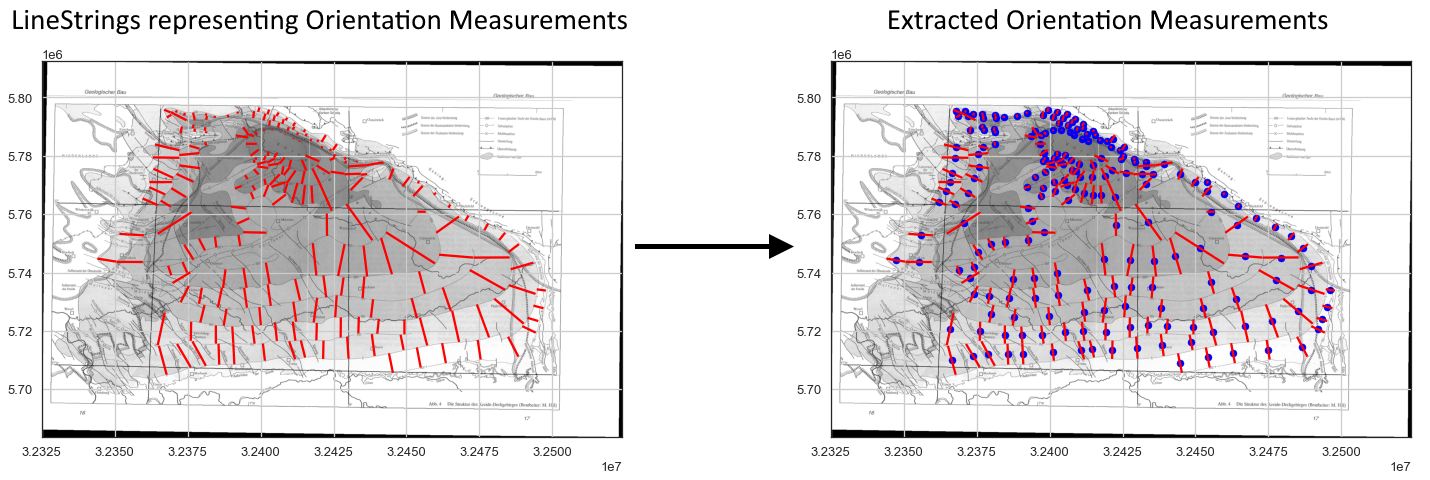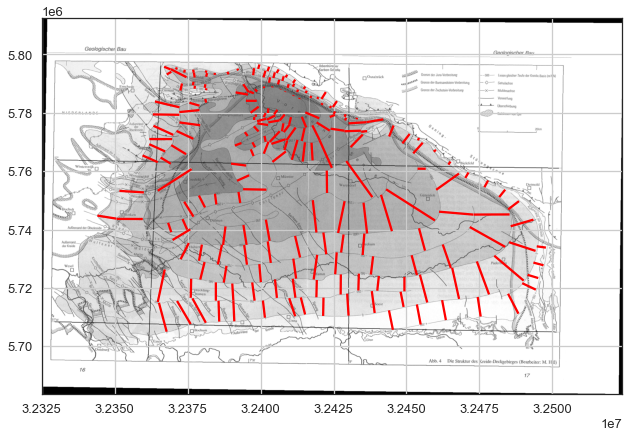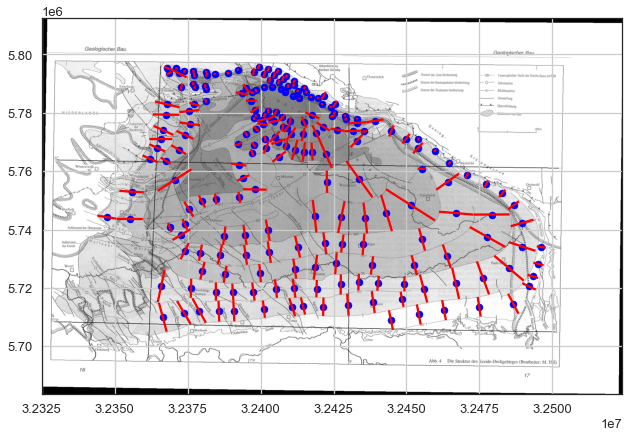25 Creating Orientations from Isolines on Maps
Contents
25 Creating Orientations from Isolines on Maps#
Orientations can be calculated from LineStrings representing the highest gradient between two or more isolines of a surface.

Source: Geologie im Münsterland (1995) by Günter Drozdzewski, Martin Hiss, Franziska Lehmann, Gert Michel, Klaus Skupin, Henner Staude, Arend Thiermann, Hildegard Dahm-Arens, Walter Finke.
Set File Paths and download Tutorial Data#
If you downloaded the latest GemGIS version from the Github repository, append the path so that the package can be imported successfully. Otherwise, it is recommended to install GemGIS via pip install gemgis and import GemGIS using import gemgis as gg. In addition, the file path to the folder where the data is being stored is set. The tutorial data is downloaded using Pooch (https://www.fatiando.org/pooch/latest/index.html) and stored in the specified folder. Use
pip install pooch if Pooch is not installed on your system yet.
[1]:
import gemgis as gg
file_path ='data/25_creating_orientations_from_isolines_on_maps/'
WARNING (theano.configdefaults): g++ not available, if using conda: `conda install m2w64-toolchain`
C:\Users\ale93371\Anaconda3\envs\test_gempy\lib\site-packages\theano\configdefaults.py:560: UserWarning: DeprecationWarning: there is no c++ compiler.This is deprecated and with Theano 0.11 a c++ compiler will be mandatory
warnings.warn("DeprecationWarning: there is no c++ compiler."
WARNING (theano.configdefaults): g++ not detected ! Theano will be unable to execute optimized C-implementations (for both CPU and GPU) and will default to Python implementations. Performance will be severely degraded. To remove this warning, set Theano flags cxx to an empty string.
WARNING (theano.tensor.blas): Using NumPy C-API based implementation for BLAS functions.
[2]:
gg.download_gemgis_data.download_tutorial_data(filename="25_creating_orientations_from_isolines_on_maps.zip", dirpath=file_path)
Loading data#
The data used here represents the base of the Münsterland Basin in northern Germany.
The map was extracted from ‘Geologie im Münsterland’ (1995) by Günter Drozdzewski, Martin Hiss, Franziska Lehmann, Gert Michel, Klaus Skupin, Henner Staude, Arend Thiermann, Hildegard Dahm-Arens, Walter Finke. The orientation values were digitized in QGIS.
[2]:
import rasterio
import geopandas as gpd
raster = rasterio.open(file_path + 'Tiefenlage_BasisKreide_georeferenziert.tif')
WARNING (theano.configdefaults): g++ not available, if using conda: `conda install m2w64-toolchain`
C:\Users\ale93371\Anaconda3\envs\test_gempy\lib\site-packages\theano\configdefaults.py:560: UserWarning: DeprecationWarning: there is no c++ compiler.This is deprecated and with Theano 0.11 a c++ compiler will be mandatory
warnings.warn("DeprecationWarning: there is no c++ compiler."
WARNING (theano.configdefaults): g++ not detected ! Theano will be unable to execute optimized C-implementations (for both CPU and GPU) and will default to Python implementations. Performance will be severely degraded. To remove this warning, set Theano flags cxx to an empty string.
WARNING (theano.tensor.blas): Using NumPy C-API based implementation for BLAS functions.
[3]:
orientations = gpd.read_file(file_path + 'bottom_cret_orient.shp')
orientations.head()
[3]:
| id | dZ | geometry | |
|---|---|---|---|
| 0 | None | 500 | LINESTRING (32478299.585 5717761.236, 32474124... |
| 1 | None | 500 | LINESTRING (32468027.985 5716203.394, 32465662... |
| 2 | None | 500 | LINESTRING (32457110.971 5715004.084, 32454603... |
| 3 | None | 250 | LINESTRING (32449009.343 5713465.851, 32447984... |
| 4 | None | 250 | LINESTRING (32439984.702 5719017.270, 32440531... |
Plotting the Data#
The orientations consist of LineStrings consisting of two points and were digitized along the steepest gradient between two isolines/contour lines.
[4]:
import matplotlib.pyplot as plt
from rasterio.plot import reshape_as_image
fig, ax = plt.subplots(1,1)
orientations.plot(ax=ax, aspect='equal', color='red')
ax.imshow(reshape_as_image(raster.read()), extent=[raster.bounds[0], raster.bounds[2], raster.bounds[1], raster.bounds[3]], cmap='gray')
plt.grid()

Extracting Orientations#
The orientations can be extracted from the map using extract_orientations_from_map(..).
[5]:
gdf = gg.vector.extract_orientations_from_map(gdf=orientations)
gdf
[5]:
| geometry | azimuth | dip | X | Y | polarity | |
|---|---|---|---|---|---|---|
| 0 | POINT (32476212.059 5723406.886) | 339.71 | 2.38 | 32476212.06 | 5723406.89 | 1 |
| 1 | POINT (32466845.216 5721529.592) | 347.48 | 2.62 | 32466845.22 | 5721529.59 | 1 |
| 2 | POINT (32455857.358 5719760.010) | 345.23 | 2.91 | 32455857.36 | 5719760.01 | 1 |
| 3 | POINT (32448496.843 5716069.354) | 348.86 | 2.70 | 32448496.84 | 5716069.35 | 1 |
| 4 | POINT (32440258.151 5721545.726) | 6.17 | 2.81 | 32440258.15 | 5721545.73 | 1 |
| ... | ... | ... | ... | ... | ... | ... |
| 201 | POINT (32397115.154 5766347.158) | 337.75 | 5.77 | 32397115.15 | 5766347.16 | 1 |
| 202 | POINT (32401900.665 5768063.700) | 21.43 | 3.24 | 32401900.67 | 5768063.70 | 1 |
| 203 | POINT (32406348.070 5764968.723) | 52.21 | 2.44 | 32406348.07 | 5764968.72 | 1 |
| 204 | POINT (32397999.433 5753733.174) | 271.12 | 1.79 | 32397999.43 | 5753733.17 | 1 |
| 205 | POINT (32377335.907 5782940.399) | 105.95 | 7.91 | 32377335.91 | 5782940.40 | 1 |
206 rows × 6 columns
Plotting the results#
It can be seen that the locations of the orientations are the midpoints of the LineStrings.
[6]:
import matplotlib.pyplot as plt
from rasterio.plot import reshape_as_image
fig, ax = plt.subplots(1,1)
orientations.plot(ax=ax, aspect='equal', color='red')
gdf.plot(ax=ax, aspect='equal',color='blue', markersize=50)
ax.imshow(reshape_as_image(raster.read()), extent=[raster.bounds[0], raster.bounds[2], raster.bounds[1], raster.bounds[3]], cmap='gray')
plt.grid()

